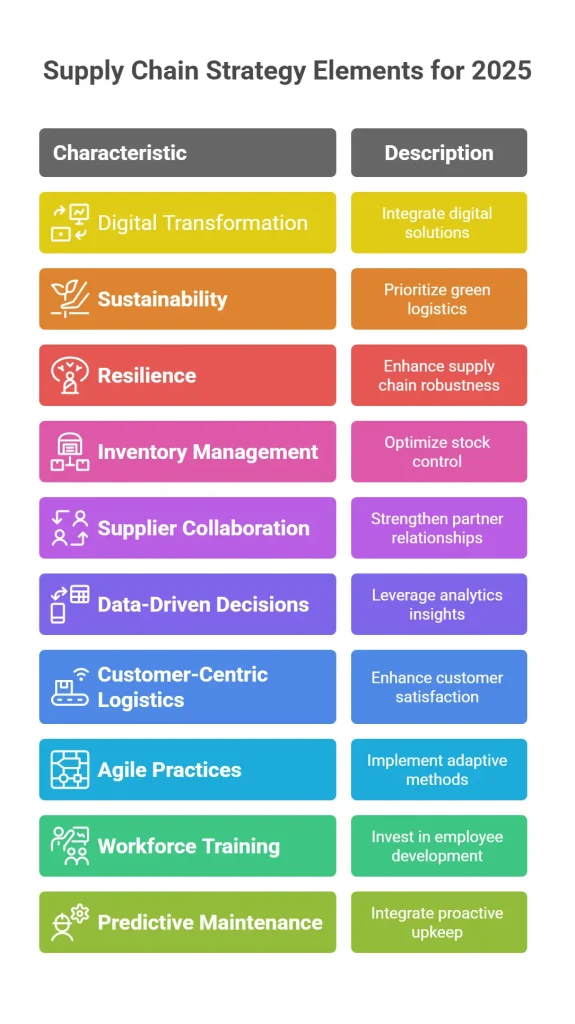In the ever-evolving global economy, businesses must continuously refine their supply chain strategy to stay competitive and resilient. As we move into 2025, companies face increasing challenges, including fluctuating demand, rising transportation costs, geopolitical tensions, and the need for sustainability. To remain ahead, businesses must develop a robust, adaptable, and technology-driven supply strategy that enhances efficiency, reduces costs, and improves overall performance.

Understanding the Importance of a Supply Chain Strategy
A supply chain strategy is a comprehensive plan that outlines how a company manages its supply chain operations to meet business objectives. It encompasses sourcing, production, logistics, and distribution while aligning with customer expectations and market trends. The right strategy ensures resilience, cost efficiency, and long-term growth.
Key benefits of a competitive supply chain strategy include:
- Enhanced operational efficiency
- Improved customer satisfaction
- Better risk management
- Cost savings
- Increased supply chain visibility
Key Elements of a Winning Supply Chain Strategy for 2025

1. Embrace Digital Transformation
Technology is revolutionizing supply chains, and companies must integrate digital solutions to streamline operations. Key advancements include:
AI and Machine Learning: Predict demand, optimize inventory, and improve decision-making.
- Blockchain Technology: Enhance transparency and traceability in the supply chain.
- Internet of Things (IoT): Enable real-time tracking and monitoring of shipments.
- Cloud Computing: Improve collaboration and data accessibility across supply chain partners.
2. Prioritize Sustainability and Green Logistics
Consumers and regulatory bodies are placing greater emphasis on sustainable practices. A future-proof supply chain strategy must include:
- Eco-friendly packaging and materials to reduce waste
- Carbon footprint reduction through optimized transportation routes
- Investment in renewable energy for manufacturing and logistics
- Supplier sustainability assessments to ensure ethical sourcing
3. Enhance Supply Chain Resilience
Disruptions such as pandemics, natural disasters, and geopolitical conflicts have highlighted the importance of resilience. To build a resilient supply chain strategy:
- Diversify suppliers to reduce dependency on a single source
- Develop contingency plans for emergencies
- Adopt nearshoring and reshoring to reduce reliance on global suppliers
- Invest in automated warehouses for faster fulfillment
4. Optimize Inventory Management
Effective inventory management is critical to reducing costs and meeting demand. Key strategies include:
- Just-in-Time (JIT) Inventory: Minimize excess stock and storage costs
- AI-driven demand forecasting: Use predictive analytics to align stock levels with demand
- Automated warehouse systems: Improve picking, packing, and order accuracy
- Omnichannel inventory visibility: Synchronize inventory across multiple sales channels
5. Strengthen Supplier Collaboration
A successful manufacturing supply chain strategy involves strong partnerships with suppliers. Collaboration can be improved by:
- Implementing Supplier Relationship Management (SRM) tools to enhance communication
- Sharing real-time data for better logistics strategy and planning
- Building long-term strategic partnerships for stability
- Aligning business goals with supplier capabilities
6. Leverage Data-Driven Decision Making
Data analytics plays a crucial role in modern supply chains. Companies should:
- Use real-time analytics for demand sensing and forecasting
- Implement key performance indicators (KPIs) to track supply chain efficiency
- Adopt automated reporting tools for better decision-making
- Integrate AI-driven dashboards to gain deeper insights
7. Enhance Customer-Centric Logistics
Customer satisfaction is a key driver of business success. To improve logistics:
- Offer fast and flexible transportation strategy in supply chain such as same-day or next-day shipping
- Provide real-time tracking for better transparency
- Use AI-powered chatbots for improved customer service
- Optimize last-mile delivery with smart logistics solutions
8. Implement Agile Supply Chain Practices
Agility is crucial for adapting to market changes. Businesses should:
- Develop cross-functional teams to improve responsiveness.
- Adopt modular supply chain designs for scalability.
- Utilise digital twins to simulate and optimise workflows.
9. Invest in Workforce Training and Development
To build a future-ready supply chain workforce:
- Provide upskilling programs in data analytics and automation.
- Encourage cross-training to enhance adaptability.
- Adopt remote-friendly solutions for supply chain management roles.
- Foster a culture of innovation for continuous improvement.
10. Integrate Predictive Maintenance
To reduce equipment downtime and improve efficiency:
- Use IoT sensors to monitor machinery health.
- Leverage AI for predictive analytics to anticipate failures.
- Automate maintenance scheduling to prevent disruptions.
Conclusion
A well-defined supply chain strategy is the backbone of any successful business. As we move into 2025, companies must embrace digital transformation, prioritize sustainability, build resilience, and leverage data-driven decision-making. By focusing on customer-centric logistics and strengthening supplier collaboration, businesses can create a future-ready logistics strategy that ensures growth and competitiveness in an ever-changing market. Do you need to future-proof your supply chain? Contact Qodenext today.
FAQs: The Ultimate Supply Chain Strategy for 2025
1. What is a supply chain strategy, and why is it important?
A logistics strategy is a structured approach to managing procurement, production, logistics, and distribution. It is essential for improving efficiency, reducing costs, and ensuring customer satisfaction.
2. How can digital transformation enhance my supply strategy?
Digital transformation enables better data analytics, real-time tracking, and automation, leading to improved efficiency, cost reduction, and enhanced decision-making capabilities.
3. What role does sustainability play in a modern supply strategy?
Sustainability reduces environmental impact, meets regulatory compliance, and improves brand reputation, making it a crucial part of any supply strategy for 2025.
4. How can I make my supply chain more resilient?
To enhance resilience, diversify suppliers, invest in automation, develop contingency plans, and consider nearshoring or reshoring production.
5. What technologies should I integrate into my supply strategy?
AI, machine learning, IoT, blockchain, and cloud computing are key technologies that can optimize a supply strategy for efficiency and transparency.
6. How does inventory management impact supply strategy?
Efficient inventory management minimizes costs, reduces waste, and ensures product availability, improving overall supply chain performance.
7. Why is supplier collaboration important?
Strong supplier relationships lead to better communication, improved reliability, and reduced risks, ultimately enhancing supply chain efficiency.
8. How can data analytics improve supply chain decision-making?
Data analytics provides insights into demand patterns, supplier performance, and operational efficiency, allowing for proactive decision-making and optimization.
9. What are the benefits of customer-centric logistics?
Customer-centric logistics improve satisfaction, increase retention rates, and boost sales by offering fast, reliable, and transparent delivery services.
10. How can I future-proof my supply chain for 2025 and beyond?
Invest in technology, prioritize sustainability, build resilience, optimize inventory management, and strengthen supplier relationships to create a robust supply strategy.







